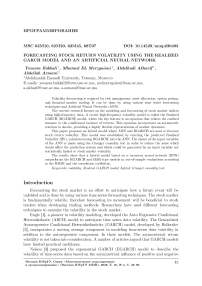Forecasting stock return volatility using the realized Garch model and an artificial neural network
Автор: Youssra B., Mhamed El.M., Abdelhadi A., Abdellah A.
Рубрика: Программирование
Статья в выпуске: 4 т.16, 2023 года.
Бесплатный доступ
Volatility forecasting is required for risk management, asset allocation, option pricing, and financial market trading. It can be done by using various time series forecasting techniques and Artificial Neural Networks (ANN). The current research focuses on the modeling and forecasting of stock market indices using high-frequency data. A recent high-frequency volatility model is called the Realized GARCH (RGARCH) model, where the key feature is an equation that relates the realized measure to the conditional variance of returns. This equation incorporates an asymmetric reaction to shocks, providing a highly flexible representation of market dynamics. This paper proposes an hybrid model where ANN and RGARCH are used to forecast stock return volatility. This model was established by entering the predicted Realized Volatility (RV), calculated using RGARCH, into the ANN. The choice of the input variables of the ANN is made using the Granger causality test in order to reduce the noise which would affect the prediction system and which could be generated by an input variable not statistically linked to stock market volatility. The results show that a hybrid model based on a recurrent neural network (RNN) outperforms the RGARCH and HAR-type models in out-of-sample evaluations according to the RMSE and the correlation coefficient.
Volatility, realized garch model, hybrid, granger causality test
Короткий адрес: https://sciup.org/147242588
IDR: 147242588 | УДК: 519.2 | DOI: 10.14529/mmp230403
Список литературы Forecasting stock return volatility using the realized Garch model and an artificial neural network
- Engle R.F. Autoregressive Conditional Heteroscedasticity with Estimates of the Variance of United Kingdom Inflation. Econometrica, 1982, vol. 50, pp. 987–1007. DOI: 10.2307/1912773
- Bollerslev T. Generalized Autoregressive Conditional Heteroskedasticity. Journal of Econometrics, 1986, vol. 31, no. 3, pp. 307–327. DOI: 10.1016/0304-4076(86)90063-1
- Nelson D.B. Conditional Heteroskedasticity in Asset Returns: a New Approach. Econometrica, 1991, vol. 59, no. 2, pp. 347–370. DOI: 10.2307/2938260
- Eryilmaz F.M. Modelling Stock Market Volatility: The Case of Bist-100. International Journal of Commerce and Finance, 2015, vol. 2, no. 1, pp. 37–53.
- Andersen T.G., Bollerslev T., Diebold F.X., Ebens H. The Distribution of Realized Stock Return Volatility. Journal of Financial Economics, 2001, vol. 61, no. 1, pp. 43–76. DOI: 10.1016/S0304-405X(01)00055-1
- Barndorff-Nielsen O.E., Shephard N. Econometric Analysis of Realized Volatility and Its Use in Estimating Stochastic Volatility Models. Journal of the Royal Statistical Society, 2002, vol. 64, no. 2, pp. 253–280. DOI: 10.1111/1467-9868.00336
- Hansen P.R., Zhuo Huang, Shek H.H. Realized GARCH: a Joint Model for Returns and Realized Measures of Volatility. Journal of Applied Econometrics, 2012, vol. 27, no. 6, pp. 877–906. DOI: 10.1002/jae.1234
- Barndorff-Nielsen O.E., Shephard N. Power and Bipower Variation with Stochastic Volatility and Jumps. Journal of Financial Econometrics, 2004, vol. 2, no. 1, pp. 1–48. DOI: 10.1093/jjfinec/nbh001
- Lee S.S., Mykland P.A. Jumps in Financial Markets: A New Nonparametric Test and Jump Dynamics. Review of Financial Studies, 2008, vol. 21, no. 6, pp. 2535–2563. DOI: 10.2139/ssrn.686372
- Ait-Sahalia Y., Mancini L. Out of Sample Forecasts of Quadratic Variation. Journal of Econometrics, 2008, vol. 147, no. 1, pp. 17–33. DOI: 10.1016/j.jeconom.2008.09.015
- Boudt K., Boudt P., Brian G., Croux C. Estimation and Decomposition of Downside Risk for Portfolios with Non-Normal Returns. Journal of Risk, 2008, vol. 11, no. 2, pp. 79–103. DOI: 10.2139/ssrn.1024151
- Corsi F. A Simple Long Memory Model of Realized Volatility. Journal of Financial Econometrics, 2009, vol. 7, no. 2, pp. 174–196. DOI: 10.1093/jjfinec/nbp001
- Zhang Peter, Patuwo Eddy, Hu Michael. Forecasting With Artificial Neural Networks: The State of the Art. International Journal of Forecasting, 1998, vol. 14, no. 1, pp. 35–62. DOI: 10.1016/S0169-2070(97)00044-7
- Fausett L. Fundamentals of Neural Network. Hoboken, Prentice-Hall, 1994.
- Xunfa Lu, Danfeng Que, Guangxi Cao. Volatility Forecast Based on the Hybrid Artificial Neural Network and GARCH-type Models. Procedia Computer Science, 2016, vol. 91, pp. 1044–1049. DOI: 10.1016/j.procs.2016.07.145
- Vortelinos D.I. Forecasting Realized Volatility: HAR Against Principal Components Combining Neural Networks and GARCH. Research in International Business and Finance, 2017, vol. 39, pp. 824–839. DOI: 10.1016/j.ribaf.2015.01.004
- Arneri´c J., ˇ Sestanovi´c T., Teai J. Neural Network Approach in Forecasting Realized Variance Using High-Frequency Data. Business Systems Research Journal, 2018, vol. 9, no. 2, pp. 18–34. DOI: 10.2478/bsrj-2018-0016
- Huang Shih-Feng, Chiang Hsin-Han, Lin Yu-Jun. A Network Autoregressive Model with GARCH Effects and its Applications. The Public Library of Science One, 2021, vol. 16, no. 7, article ID: e0255422. DOI: 10.1371/journal.pone.0255422
- Granger C. Investigating Causal Relations by Econometric Models and Cross-spectral Methods. Econometrica, 1969, vol. 37, no. 3, pp. 424–438. DOI: 10.2307/1912791
- Funahashi K. On the Approximate Realization of Continuous Mappings by Neural Networks. Neural Networks, 1989, vol. 2, no. 3, pp. 183–192. DOI: 10.1016/0893-6080(89)90003-8
- Hornik K., Stinchcombe M., White H. Universal Approximation of an Unknown Mapping and its Derivatives Using Multilayer Feedforward Networks. Neural Networks, 1990, vol. 3, no. 5, pp. 551–560. DOI: 10.1016/0893-6080(90)90005-6


